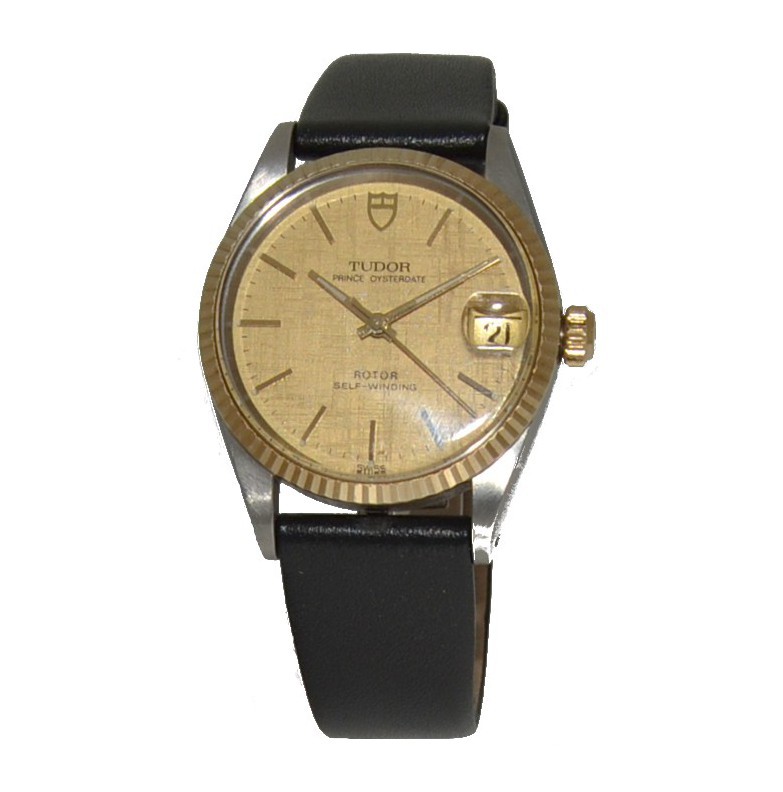
Call us on: 01262 437170
Tudor Prince Oysterdate 72033
Tuesday 20th August 2013
We serviced this customers Tudor watch and received this résumé of the timepiece.
Manufactured in 1992/3, this is the most controversial watch I own for three reasons:
1) it is mid-size;
2) it is two-tone;
3) it is often dismissed as a ‘poor man’s Rolex’.
Mid-size watches in the 32-34mm range are regularly misclassified as boy’s/cadet size or unisex . For much of the second half of the C20th, however, men’s watches were commonly produced in sizes of between 30 and 32mm, with true boy’s size being around 28mm. The fashion for large watches (40mm plus) developed only from the late 1990s onwards and is associated with a certain machismo. For someone with a slender wrist, 32mm (35mm including crown) is extremely comfortable. Only the ‘cocktail’ or ‘ladies’ watches of 28mm or below (some a mere 12mm!) are truly small watches: pieces that have become increasingly rare sights on the wrists of either sex.
The fashion for larger cases means that mid-size offers high-specification at a comparatively modest price. 316L SS case with polished sides and brushed top with drilled lugs. 18k gold fluted bezel. Screw-down twin-lock gold crown signed with Rolex logo. Champagne mosaic dial with tritium-tipped gold hour batons. Tudor shield logo at 12. Matching gold baton minute and hour hands with tritium inlays, now with little residual energy given Tritium's half-life of 12.32 years. Most of the luminosity is an after-glow effect lasting only a few minutes, created by sunlight activating the phosphorescence in the zink sulphide pigment. Gold sweep second hand. Brushed finished solid SS case back with serrations. Engraved ‘original oyster case by Rolex Geneva’ and the Rolex logo.
The watch comes with a SS and gold-plated bracelet (reference 6248-17) stamped ‘Tudor Watch Co. Geneva Switzerland’ with two-tone hollow end links (reference 601) and folding buckle. While the two-tone decoration is ideal for formal wear, care is needed to preserve the gold plating which (sadly) is not the real thing. For regular use, I prefer alternative formulations. On occasion, I have worn the piece on a black leather strap with a 14mm SS butterfly deployment clasp. This is not ideal, however, because the gap between the lugs is noticeable and sourcing a curved end 17mm strap to mask this is difficult. A thicker (3mm) NATO strap would camouflage the lug problem but looks odd on a dress watch. Perhaps a Tudor strap and gold buckle might be a better course - but at £200 it is an expensive option. My preferred solution is a good-quality 316L SS aftermarket Jubilee watch band with SEL. This is controversial because the bracelet is non-Tudor and not everyone agrees with matching a SS band with a SS case and gold bezel.
The Oyster Prince utilises an ETA 2824-2 movement finished to the highest specification. Top (A+) is functionally equivalent to Chronometer standard except that the movement is not officially certified as such. All 2824-2 A+ grades are regulated in five positions, have balance wheels made from Glucydur (rather than nickel) and a hairspring and mainspring made from Niravox. Glucydur is an alloy of beryllium, copper, and iron; Niravox is an anti-magnetic alloy. The low thermal expansion of the former material and low thermal coefficient of elasticity of the latter cancel each other out, enabling temperature changes to be compensated for. In addition, the movement incorporates incabloc shock absorbant springs to protect delicate pivots and jewel bearings against impact damage.
Despite the ETA 2824-2’s high quality, the differences between this movement and the caliber 3130 used in an Oyster Perpetual (the Rolex equivalent model) are significant. The 3130 has a crescent-shaped balance bridge, rather than a balance cock. This is more effective in preventing the rotor’s edge from hitting the balance wheel’s rim in the event of a perpendicular impact. Kif or Paraflex shock absorbers also provide greater protection than incabloc systems. Older Rolex models feature a Breguet overcoil hairspring made from Nivarox. Newer ones employ an in-house Parachrom Blu hairspring. Both combat the tendency for a watch to speed up when the mainspring winds down, owing to reduced pull on the hairspring. The 3130 is regulated in the same number of positions as the 2824-2. In the case of the ETA movement, however, regulation is achieved using a sliding spring inhibitor that adjusts the balance spring. The Rolex movement, in contrast, leaves the balance wheel free sprung and utilises weighted, rotatable Microstella screws mounted on pins at the junction of the balance arms and rim. Regulation is achieved by turning the mass of the weight towards the inside or outside of the balance. The absence of protruding screws on the rim permits the balance wheel to be larger and more aerodynamic. Oyster Perpetual’s also have a longer main spring, increasing the power reserve (the ETA has a rather miserly 38 hours). Other elaborations include a more sophisticated date change mechanism. Consequently, a caliber 3130 is a more accurate and refined movement than a 2824-2. In this respect, therefore, a Tudor can be considered a poor man’s Oyster Perpetual. The ETA, however, can be serviced independently of Rolex’s Service Centres, keeping maintenance costs low. Currently, the only difficult part to source is the Acrylic crystal which has to be obtained from authorised workshops (sapphire aftermarket alternatives with gaskets pose waterproofing issues). The Cyclops 141 provides 2½ magnification of the quick-set date window at 3pm.
The 72033 is an ideal piece to wear during the evenings after work: reducing weight on the wrist helps take weight off the mind.
Prof Simon Smith, Oxford University.
